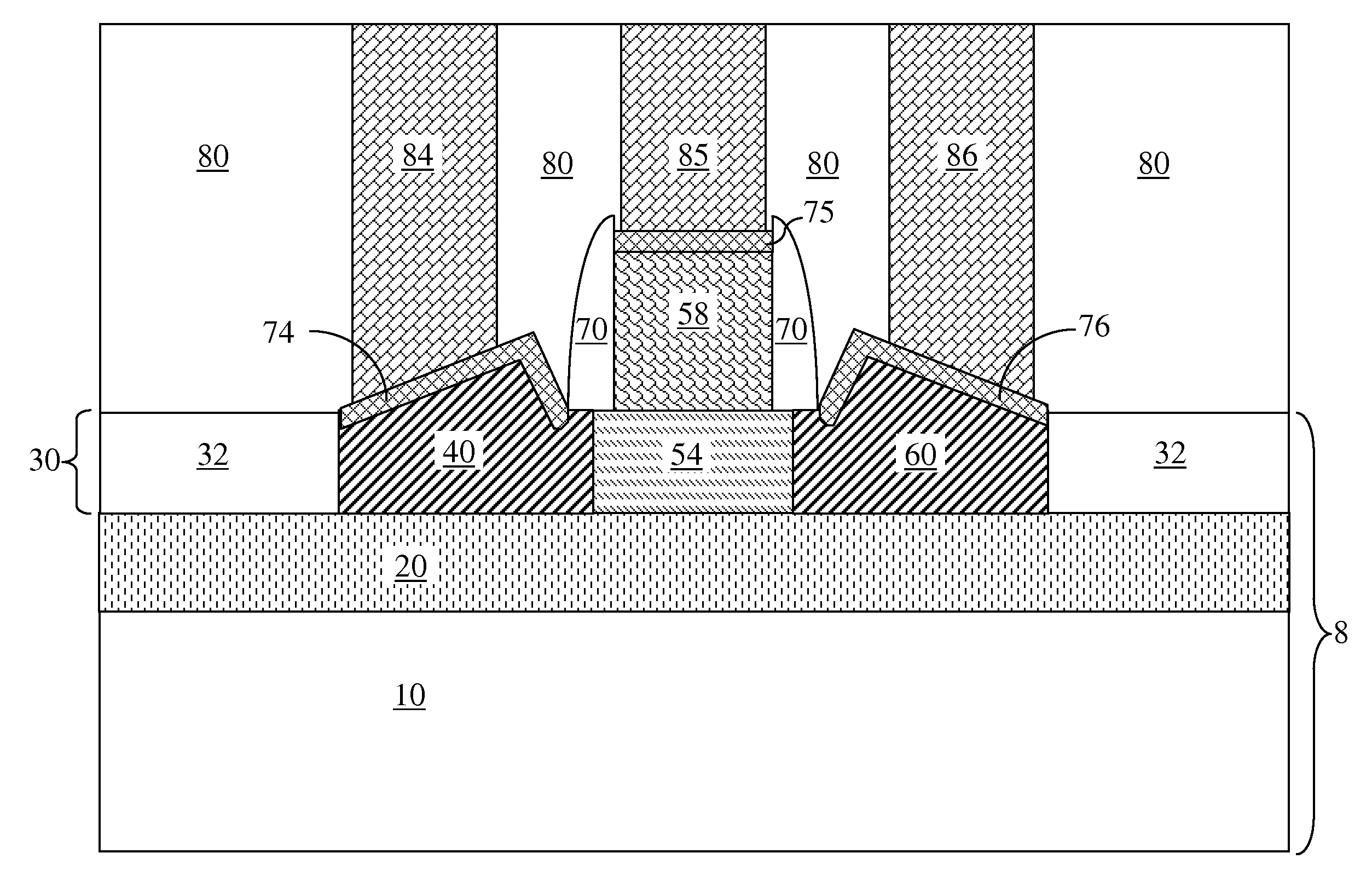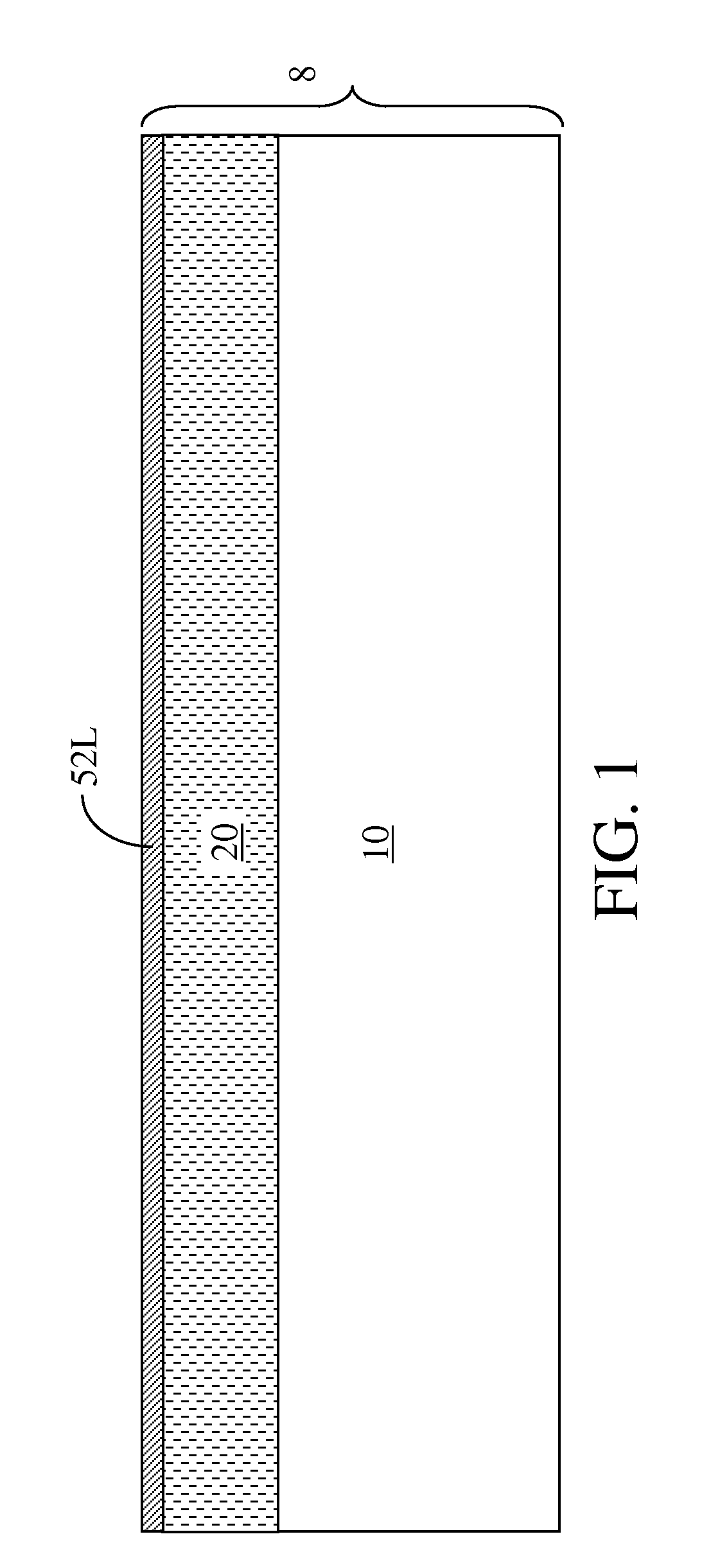SOI SiGe-Base Lateral Bipolar Junction Transistor
a lateral bipolar junction and transistor technology, applied in the field of lateral bipolar transistors, can solve the problems of performance limiting factors for bipolar junctions, noise generated at the periphery of the base is another performance limiting factor, and the capacitance between the extrinsic base, so as to minimize the introduction of noise, reduce the effect of parasitic capacitance and increase current density
- Summary
- Abstract
- Description
- Claims
- Application Information
AI Technical Summary
Benefits of technology
Problems solved by technology
Method used
Image
Examples
first embodiment
[0022]Referring to FIG. 1, a first exemplary semiconductor structure according to the present disclosure includes a substrate 8 including at least a dielectric material layer and a silicon layer located on a top surface of the dielectric material layer. The substrate 8 can be, for example, a semiconductor-on-insulator (SOI) substrate, which includes a handle substrate 10, a buried insulator layer 20 contacting a top surface of the handle substrate 10, and a silicon layer contacting a top surface of the buried insulator layer 20. This silicon layer is herein referred to as a lower silicon layer 52L because another silicon layer can be subsequently formed over the lower silicon layer 52L.
[0023]The handle substrate 10 can include a semiconductor material, an insulator material, a conductor material, or a combination thereof. In one example, the handle substrate 10 can include a semiconductor material such as silicon. If the handle substrate 10 includes a semiconductor material, the han...
second embodiment
[0056]Referring to FIG. 10, a second exemplary semiconductors structure according to the present disclosure can be derived from the first exemplary semiconductor structure shown in FIG. 7 by omitting the formation of the upper silicon layer 56L at a processing step corresponding to FIG. 2. As a consequence, an upper silicon base region is not formed in the second exemplary semiconductor structure, and the base 50 includes only a lower silicon base region 52 and a silicon-germanium base region 54. The silicon-germanium base region 54 contacts the bottom surfaces of the extrinsic base 58 and the dielectric spacer 70.
[0057]Referring to FIG. 11, a variation of the second exemplary semiconductors structure can be derived from the variation of the first exemplary semiconductor structure as shown in FIG. 9 by omitting the formation of the upper silicon layer 56L at a processing step corresponding to FIG. 2. As a consequence, an upper silicon base region is not formed in the variation of th...
fourth embodiment
[0062]Referring to FIG. 14, a fourth exemplary semiconductor structure according to the present disclosure is derived from the third exemplary semiconductor structure of FIG. 13 by omitting formation of the upper silicon layer 56L. In the fourth exemplary semiconductor structure, the base 50 consists of the silicon-germanium base region 54. The silicon-germanium base region 54 has a doping of the first conductivity type, and contacts a top surface of the buried insulator layer 20, the emitter 40, the collector 60, and a bottom surface of the extrinsic base 58. A first heterojunction is formed between the emitter 40 and the base 50, and a second heterojunction is formed between the base 50 and the collector.
[0063]In each of the exemplary semiconductor structures illustrated above, the collector current flows primarily in and through a silicon-germanium alloy region, i.e., the silicon-germanium base region 54, which has a smaller band gap than silicon regions, i.e., the upper silicon ...
PUM
| Property | Measurement | Unit |
|---|---|---|
| thicknesses | aaaaa | aaaaa |
| thicknesses | aaaaa | aaaaa |
| thicknesses | aaaaa | aaaaa |
Abstract
Description
Claims
Application Information
 Login to View More
Login to View More - R&D
- Intellectual Property
- Life Sciences
- Materials
- Tech Scout
- Unparalleled Data Quality
- Higher Quality Content
- 60% Fewer Hallucinations
Browse by: Latest US Patents, China's latest patents, Technical Efficacy Thesaurus, Application Domain, Technology Topic, Popular Technical Reports.
© 2025 PatSnap. All rights reserved.Legal|Privacy policy|Modern Slavery Act Transparency Statement|Sitemap|About US| Contact US: help@patsnap.com



